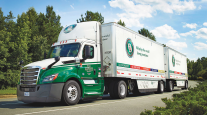Staff Reporter
Old Dominion Freight Line Q2 Profit Falls 22.3% Year-On-Year

[Stay on top of transportation news: Get TTNews in your inbox.]
Old Dominion Freight Line Inc. profits fell 22.3% year-over-year to $292.4 million in the second quarter of 2023 from $376.1 million in the year-ago period, it said.
The Thomasville, N.C.-based less-than-truckload carrier’s diluted earnings per share fell 19.7% year-on-year to $2.65 from $3.30 in the year-ago period, it added.
But the company’s EPS in the most recent quarter narrowly beat consensus analyst expectations, according to Zacks Equity Research. Consensus EPS was $2.63, Zacks said.
However, Old Dominion missed analyst expectations on revenues marginally. The consensus estimate was $1.44 billion, according to Zacks. The company’s total revenue in the most recent quarter fell 15.2% year-over-year to $1.41 billion from $1.67 billion in the same period a year earlier.
Old Dominion’s LTL services revenue totaled $1.398 billion in the three months that ended June 30, a 15% decrease compared with $1.645 billion in the year-ago period.
Old Dominion, led by newly installed CEO Marty Freeman, ranks No. 10 on the Transport Topics Top 100 list of the largest for-hire carriers in North America and is ranked No. 2 on the LTL list, behind only FedEx Freight.
“Old Dominion’s second-quarter financial results reflect continued softness in the domestic economy,” Freeman, who replaced Greg Gantt, said in a statement.
Freeman said the decrease in revenue was largely due to a 14.1% decline in LTL tons per day and a 1.1% dip in LTL revenue per hundredweight.
“This yield metric was impacted by the significant decrease in the price of diesel fuel, as our LTL revenue per hundredweight, excluding fuel surcharges, increased 7.6% during the quarter,” he added.

How effective have third-party services proved to be for fleets? Let's find out with Michael Precia of Fleetworthy Solutions and Dan Rutherford with Summit Virtual CFO by Anders. Tune in above or by going to RoadSigns.ttnews.com.
U.S. on-highway diesel prices averaged $3.767 per gallon in the final week of the second quarter of 2023, $1.908 a gallon cheaper than a year earlier.
Old Dominion maintained its market share during the second quarter, Freeman said during the company’s quarterly earnings call July 26, although the company has 30% excess capacity in its service center network, compared with a 25% target.
The company previously expected volumes to remain consistent in the third quarter; over the past week, however, Old Dominion noticed an incremental increase in revenue, Chief Financial Officer Adam Satterfield said.
Shipments are now about 50,000 per day, beating prior expectations by around 1,000 or 1,500 shipments a day, Satterfield said. He said talks with customers and potential customers have intensified over the past few weeks, although he said it was not just about the situation involving competitors, and the executive steered clear of naming embattled LTL rival Yellow Corp.
Stifel Director of Global Logistics & Future Mobility Bruce Chan said in a July 26 research note the earnings were solid and that while freight volumes are expected to remain soft through the balance of 2023, the potential for a Yellow bankruptcy could change the situation quickly for the entire LTL sector.
Want more news? Listen to today's daily briefing above or go here for more info
Chan said he expected Old Dominion was benefiting from the headlines Yellow has been generating in July, and that Old Dominion’s shipments would be roughly in line with August 2022’s 50,000-51,000 per day should freight levels hold.
Prices are not firming as a result of the dynamics of the market, with little change since the first quarter of the year, Freeman said in response to a question during the call. Chan said Old Dominion is less likely to push for price increases than its peers but would benefit should others raise the pricing floor.
If other carriers are closing the pricing gap, that bodes well for Old Dominion’s market share, Satterfield said, noting that the company was typically a little more expensive than rival carriers. “We’d be pleased to see that gap close,” he said, adding, “That would certainly help our own pricing initiatives.”




